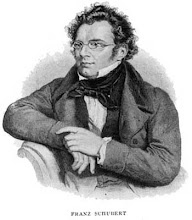Tuesday, December 9, 2008
I. History and Theory Behind Gretchen am Spinnrade, D. 118

During the the early Romantic period, a composer's focus was to express feeling instrumentally, making the composition more intimate. The German lied, an art song for voice and accompaniment, quickly came into vogue because of this idea and because of Franz Schubert. Composers often unified lieder around a common theme, creating a collection of songs called a song cycle. According to Barbara Hanning, author of Concise History of Western Music, "The song cycle became especially typical of the nineteenth century, providing a balance between small and large forms, lyric and narrative content, and unity and variety, qualities strongly valued at the time" (411). Devoted to melody, Schubert's Gretchen am Spinnrade was the first leid set to text and certainly the most famous.
Gretchen am Spinnrade was set to the text of Johann Wolfgang von Goethe, a dramatist and poet. In this particular scene, a scene from Goethe's drama Faust, Gretchen is at her spinning-wheel troubled by her feelings for Faust, a man she just met and barely knows. Gretchen am Spinnrade is a strophic poem, yet Schubert rearranged the order of each strophe so that he could illustrate and extend the drama between Faust and Gretchen. He repeated the first stanza, "My peace is gone, my heart is heavy; i'll never find peace, never again," after the third and sixth stanzas and transformed it into a refrain, so that the listener is always reminded of Gretchen's inner anguish and aching heart.
Schubert's ability to convey Gretchen's madness came from his "...strong feeling for harmonic color. His complex modulations, sometimes embodying long passages in which the tonality is kept in suspense, powerfully underline the dramatic qualities of his song texts" according to Hanning (413). Schubert masterfully modulates from several different keys, each key change a symbol and exploration of feeling. This method further expressing the intent of the text and Gretchen's heart ache. The piano accompaniment is intended to enforce the meaning and setting of the song but never to over shadow the voice. In Gretchen am Spinnrade, the melody line of the piano part emulates the spinning of the wheel, the cycle of Gretchen's thoughts, and the intensity of her feelings.
Franz Schubert composed six hundred lieder in his time. J. Peter Burkholder and Claude V. Palisca write that Schubert's lieder were often performed in intimate and informal gatherings called "Schubertiads" (NAWM 307). These song types were intended for amateurs to perform in their homes among friends. Lieder later became staples in voice recitals developing in to the story telling, folk singing we use in popular music today.
II. Analysis
I am going to analyze how Franz Schubert uses mixture, harmonic color, and rhythm to explore emotion and convey drama. I will also look at the form of the piece in connection with the text to see how the melody further expresses and strengthens the intensity of Gretchen's emotions and yearning.
Gretchen am Spinnrade is written in a loose ternary form, a three part structure. Schubert extends the first stanza by adding it after the third and sixth stanzas.
The lied begins with a rhythmic accompaniment, replicating the sound of a spinning wheel. This is not only suggested by an illustration but a literal continuous sixteenth note pattern in the right hand and the reciprocating motion of the treadle by the left hand that sets the scene. Gretchen begins to sing, expressing her most inner desires, leading the spinning wheel as her mind moves along with the rhythm of her hands.
1-11 mm.
The melody quickly changes from D minor to C major with elements of C minor. The pulsing harmonic rhythm building in intensity as the song moves to the second stanza.
English Translation [NAWM 305-306]:
My peace is gone,
my heart is heavy;
I'll never find peace,
never again.
13-21 mm.
Gretchen's distress worsens in the second and third stanzas as the harmony modulates from A minor, E minor and F major.
Where do I no have him
is to me like a tomb.
The whole world
is bitter to me.
22-29 mm.
My poor head is confused.
My poor mind
is torn apart.
31-40 mm.
Refrain:
We return to D minor cycling through to C Major and C Minor.
My peace is gone,
my heart is heavy;
I'll never find peace,
never again.
42-50 mm.
For him alone do I look
out the window.
For him alone do I go
out of the house.
51-58 mm.
His lofty bearing,
his noble figure,
the smile on his lips,
the strength of his gaze,
59-69 mm.
In my opinion this is the most dramatic moment in the piece, where the harmony moves from G minor, A flat-minor, and B flat-major. As she obsesses over kissing her lover between measures 66-68, she looses control and the accompaniment pattern stops-- declaring that she has also stopped the wheel:
and his conversation's
magical flow,
the press of his hand,
and, ah, his kiss!
71-82 mm.
My peace is gone,
my heart is heavy;
I'll never find peace,
never again.
84-92 mm.
The rising harmonic sequence in these final moments of the song further illustrates Gretchen's intense longing to embrace Faust in these next two stanzas.
My heart pines
for him.
Ash, if I could seize him
and hold him
92-100 mm.
and kiss him
all I wanted,
in his kisses
I would be lost!
101-102 mm.
Here, Schubert takes his own dramatic liberties and adds the line
"o konnt' ich ihn kussen" to fuel her longing.
Oh, if I could kiss him.
in his kisses
I would be lost!
114-118 mm.
My peace is gone,
my heart is heavy;
I'll never find peace,
never again.
-- Johann Wolfgang von Goethe

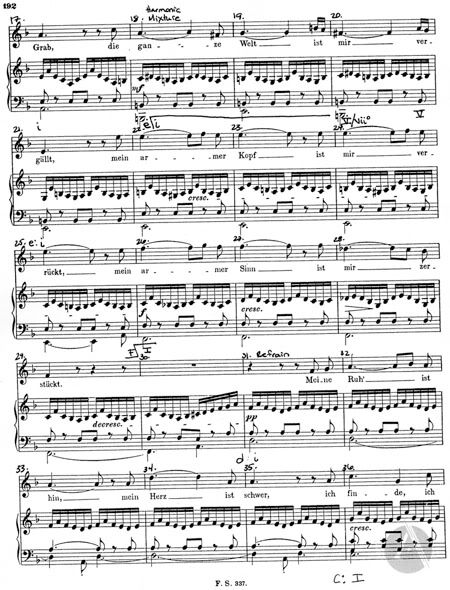
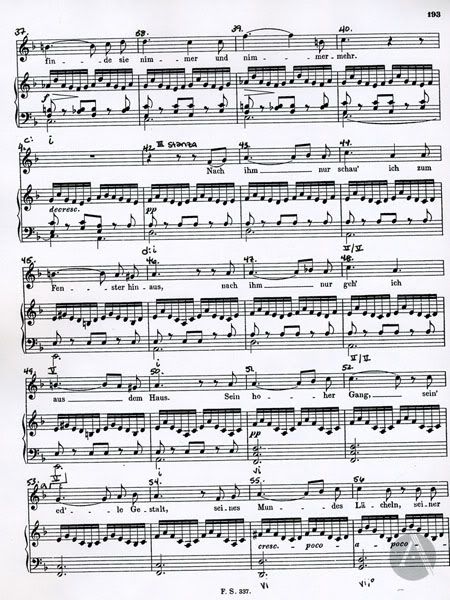
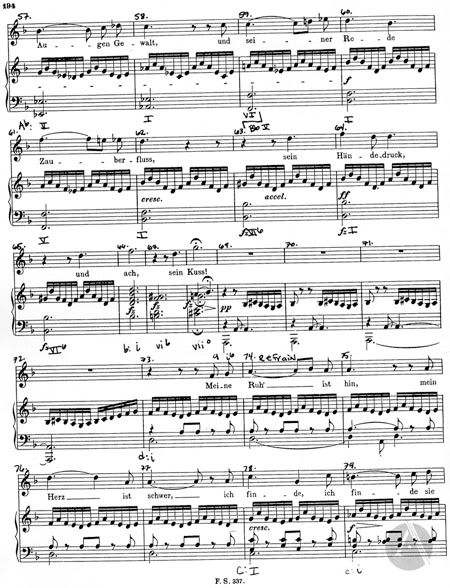
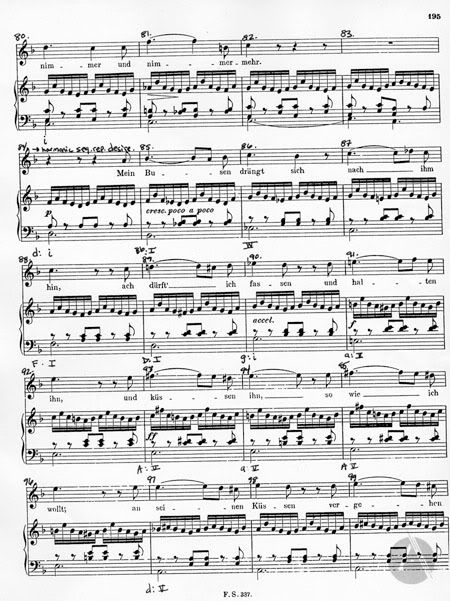
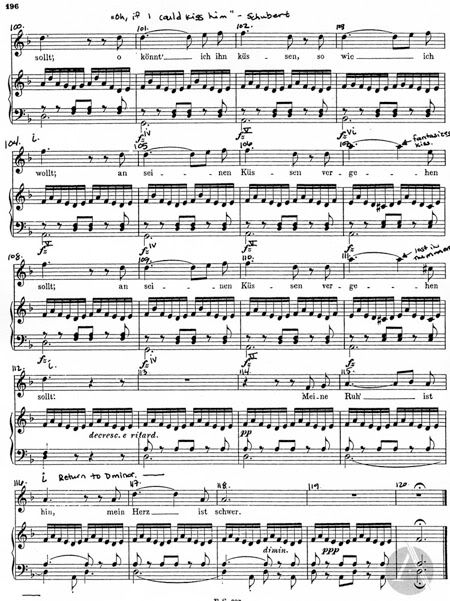
III. Conclusion and Thoughts
In my opinion there are two most significant moments of the piece. The first climatic moment is from measures 62 through to the fermata at 68. This is were the sixteenth pattern is accelerating and the dynamics are building from forte to fortissimo expressing Gretchen's inexplicable desires. This is also the point where the sixteenth note rhythmic pattern ends, she has let go of the wheel and letting herself go completely to Faust. All is quiet. Then the spinning wheel continues, a seemingly endless cycle of her emotions.
I believe that the second most climatic moment is when Gretchen completely gives into her fantasy of kissing Faust. I feel that all moments since measure 68 lead to the phrase "I would be lost" at measures 107 and 111. The Soprano reaches the highest notes of the piece, holding for almost the entire measure, exploring the loss of herself in her fantasy. The song concludes as it should, with Gretchen having no where to go, continuously lost in her day dream.
IV. Works Cited
Hanning, Barbara Russano. Concise History of Western Music Third Edition. London. W.W. Nortan & Company, 2006.
Burkholder, Peter J., Palisca, Claude V. Norton Anthology of Western Music [NAWM], Vol.2,Classic to Twentieth Century, 5th Edition (W.W.Norton). London, 2006.
Clendinning, Jane Piper, West Marvin, Elizabeth. The Musician's Guide to Theory and Analysis. W.W. Norton & Company. London, 2005.
Alexander Street Press, LLC. Music Online: Classic Scores Library. Gretchen am Spinnrade. 7 December 2008.
Web Sources:
www.wikipedia.org
www.youtube.com
Image Sources:
www.google.com
Subscribe to:
Posts (Atom)
